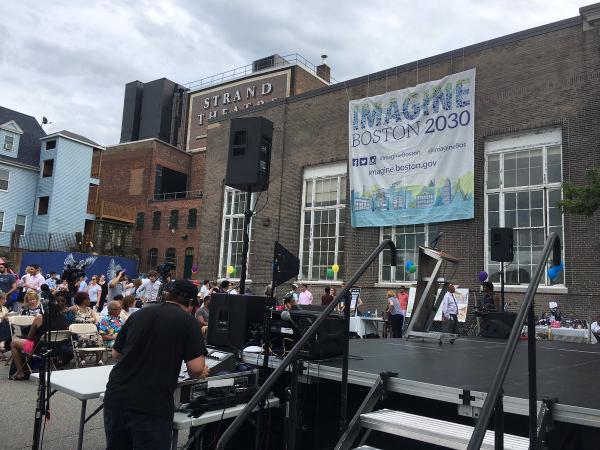August 18, 2017

The Imagine Boston 2030 launch took place beside the new library site, near the Strand Theater.
A prominent onetime bank building in the center of Uphams Corner will soon be the site of an $18 million library, Mayor Martin Walsh announced Tuesday, July 11, as he celebrated the launch of the Imagine Boston 2030 program, the city’s first major planning initiative in more than 50 years.
The library is “going to create a community space and it’s going to create access to the newest technologies,” the mayor said.
The city controls the 6,300-square foot building at 555 Columbia Rd., once home to the Dorchester Trust Company, the First National Bank of Boston, and Bank of America. The city assess- ing department values the property at $1.45 million, dramatically more than the $250,000 the Boston Planning and Development Agency (BPDA) paid for the parcel in late February, according to records with the Suffolk Country Registry of Deeds.
The property sat vacant, still owned by Bank of America, when the city purchased it. According to BPDA board memos prior to the purchase, the building “is out of repair, physically deteriorated, unfit for human habitation, obsolete, and in need of major maintenance or repair. ... the property will require environmental remediation.”
Designated for $17.98 million in the city budget, the new library is the biggest-ticket single library expenditure highlighted in the 2018 budget. The Adams Street branch is slated for a $12.3 million investment, Walsh noted.
Uphams Corner has had a branch library at 500 Columbia Rd. since 1904 when it moved into a section of the two-year- old Municipal Building at the corner of Columbia Road and Bird Street.
Its new home, neo-classical in style, with tan brick and limestone columns, was used as a bank since 1917, built on part of the Clapp-Dyer House’s lawn during an Uphams Corner’s construction boom.
“This neighborhood hasn’t really had a strong library in some time,” the mayor said earlier in the week, at a coffee hour at McConnell Park in Savin Hill on Monday. “Uphams Corner is our library branch, and... we’re gonna be making an $18 million renova- tion of a brand new library. After moving through the village, finally landing at its current location at Bird Street, Walsh said, “now Uphams Corner and this neighborhood’s going to get a great library.”
A community process will help determine the fate of the building. The capital budget includes $90,000 for planning, which will be conducted with the community, city agencies and neighbor- hood leaders.
Uphams Corner can expect a slew of planning and investment, guided by the Imagine Boston 2030 report, the culmination of almost two years of work that incorporates feedback from at least 14,000 residents.
As to releasing the report in the midst of a re-election campaign increasingly focused on the candidates’ long- term visions for the city, Walsh said “I feel good” in an interview with the Reporter last Friday. “I don’t think a lot of people know what it is, and... I think they’ll realize it was a big task. There’s a lot of good input in this document. It’s not a consultant-heavy document; it’s a constituent- heavy document.”
The launch party included an interactive showcase in the old bank building along with a block-party style celebration. Attendees milled between food trucks, a beer garden, and performers darting around a large ground mural and a playground set up in the wide lots beside the new library site.
Along with stations from city organizations and local businesses, the team behind the forthcoming combina- tion bike and coffee shop at the old Uphams Corner comfort station offered an update on its status. With permitting in line, they anticipate a rough start date in the fall for the $1.4 million project.
The city considers Uphams Corner an “Enhanced Neighborhood Pilot” area in the 2030 report. At the convergence of culture, with the Strand Theater; history and green space, including the Dorchester North Burying Ground; and transit, with the Fairmount Line stop on the commuter rail line, the city sees it primed for better connections within the village and to the rest of the city.
State Sen. Linda Dorcena Forry, an Uphams Corner native, was at the launch. “This is an incredible time. This is a rich neighborhood, an incredible community,” she said, “Dorchester is amazing. All of the city is amazing, but as a Dorchester kid, I say that Uphams Corner is in the middle of it all.”
The Imagine Boston plan is intended as a roadmap for the city’s growth, recommending more mixed-use and affordable development and better access to in- frastructural resources and green space.
“Boston is in a very unique place today,” said Dudley Street Neighborhood Initiative executive director Juan Leyton. “We have seen development as never before. We can see the economy’s thriving, but we still face many challenges.” In areas of Roxbury and Dorchester, the unemployment rate is three times the city average, Leyton noted. Access to quality educa- tion and gentri cation- prompted displacement remain real concerns for the neighborhoods, he added.
Boston’s population is rising rapidly, projected to hit 724,000 by 2030 and about 800,000 by 2050, with an anticipated 200,000 new jobs by the latter date. Planners hope to strategize their way into accommodating the growth while ensuring that all residents benefit equally.
“Imagine Boston 2030 is built on our strengths and shares them more widely,” Walsh said. “This plan is about lifting peopleup,embracingour diversity, and connecting people with good jobs. That’s what this plan is about. It’s about how do we do that, how do we move our city forward? We have a blueprint, finally, to try and do that. We’re not talking about it; we’re laying out how it’s going to happen.”
The full Imagine Boston 2030 plan is available online at imagine.boston.gov, and will soon include interactive metrics to track progress on its key initiatives.


